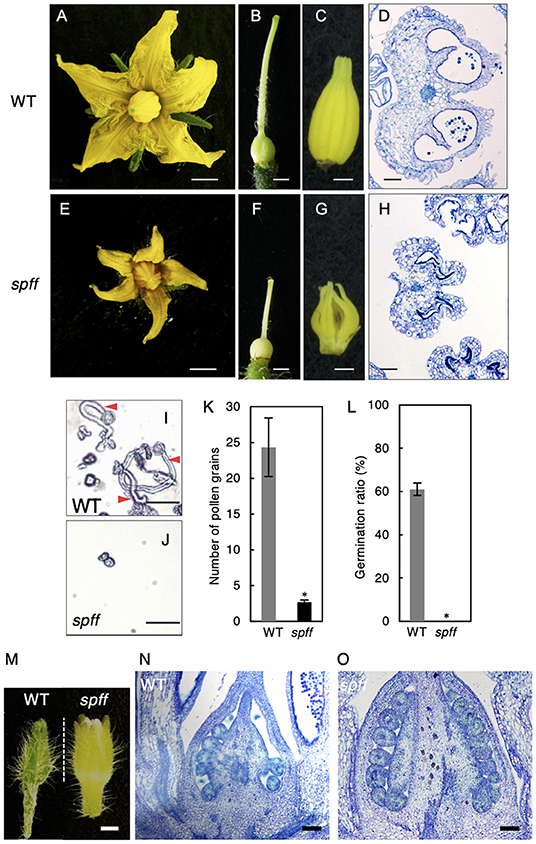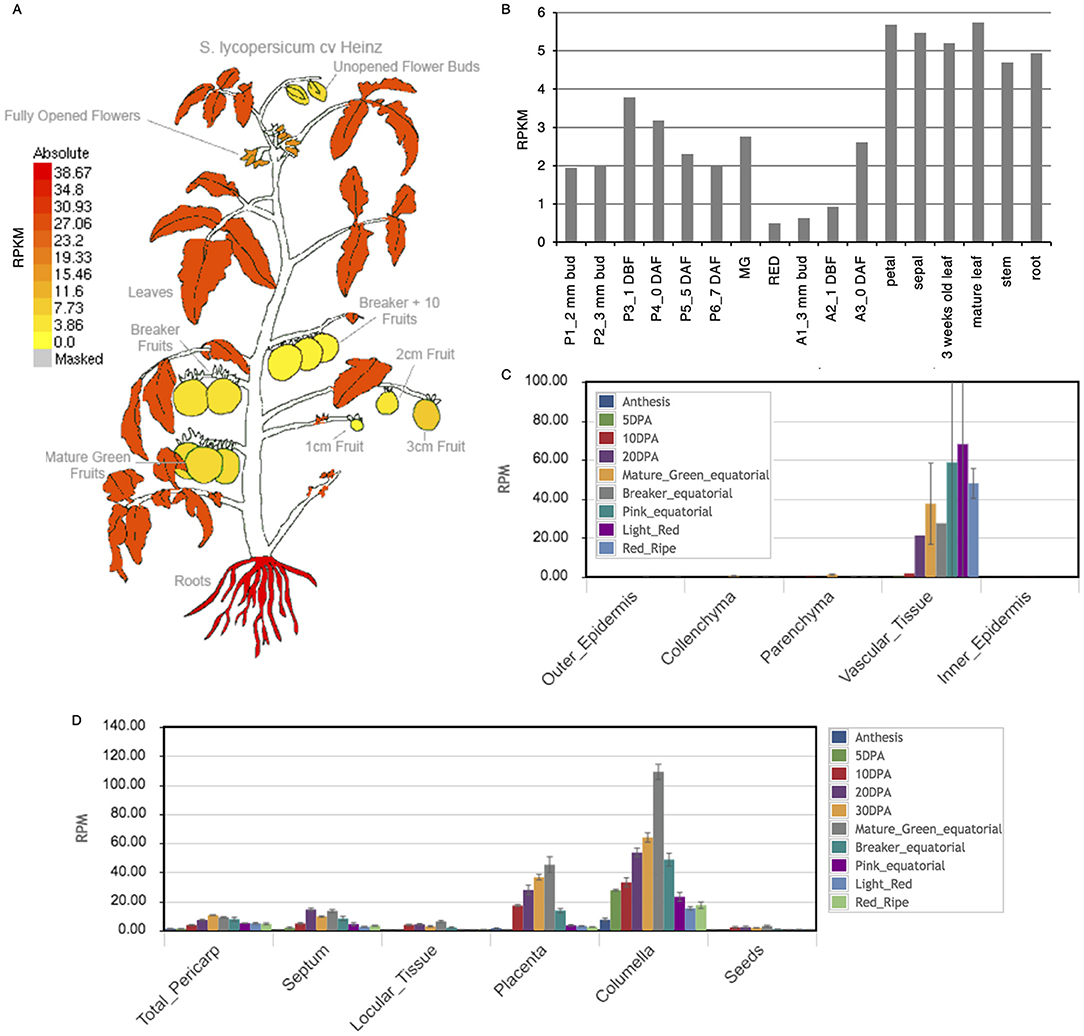Loss-of-Function of a Tomato Receptor-Like Kinase Impairs Male Fertility and Induces Parthenocarpic Fruit Set
- 1Graduate School of Life and Environmental Sciences, University of Tsukuba, Tsukuba, Japan
- 2Japan Society for the Promotion of Science (JSPS), Kôjimachi, Japan
- 3UMR1332 BFP, Institut National de la Recherche Agronomique (INRA), Villenave-d'Ornon, France
- 4UMR1332 BFP, University of Bordeaux, Bordeaux, France
- 5Tsukuba-Plant Innovation Research Center, University of Tsukuba, Tsukuba, Japan
A Corrigendum on
Loss-of-Function of a Tomato Receptor-Like Kinase Impairs Male Fertility and Induces Parthenocarpic Fruit Set
by Takei, H., Shinozaki, Y., Yano, R., Kashojiya, S., Hernould, M., Chevalier, C., et al. (2019). Front. Plant Sci. 10:403. doi: 10.3389/fpls.2019.00403
In the original article, there were mistakes in the legends for Figure 4 and Supplementary Figure 7 as published.
In the first two sentences of the legend to Figure 4, the letters attributed to the different parts of the figure were wrong. The correct legend appears below.

Figure 4. Reproductive organ phenotypes in the spff mutant. Morphology of flower (A,E), pistil (B,F), and anthers (C,G) in WT (A-C) and spff (E-G) at anthesis. Histological sections of WT (D) and spff (H) anthers at the anthesis stage. (I) Pollen tube elongation from WT pollen. Red arrowheads indicate pollen tubes. (J) Pollen grains from the spff mutant, without elongation of pollen tubes. (K) Number of pollen grains in a microscopic field. (L) Germination ratio of pollen tubes. (M) Appearance of floral bud length of 4 mm. Longitudinal section of ovaries from 4 mm floral buds (M) in WT (N) and spff (O). Bars are 2 mm (A,E); 1 mm (B,C,F,G); 100 μm (D,H,N,O), and 50 μm (I,J). At least three biological repetitions were performed and their mean values with SE are shown. Asterisks indicate significant difference between WT and spff mutant (Student t-test, p < 0.01).
The axis labels in Supplementary Figure 7B were incorrectly formatted and its legend contained some typographical errors. The corrected Supplementary Figure 7 and legend appear below.

Supplementary Figure 7. Spatiotemporal expression pattern of SPFF in various tomato organs, tissues and cells. (A) Expression images of SPFF, visualized in Tomato eFP browser (Winter et al., 2007), at tomato plant cv. Heinz 1706 organs (The Tomato Genome Consortium, 2012). (B) Expression pattern of SPFF in organs and inflorescence tissues of cv. Micro-Tom (Ezura et al., 2017). P1-6, pistil samples; MG, mature green fruits at 33 days after flowering; RED, red fruits at 44 days after flowering; A1-3, anther samples; DBF, days before flowering; DAF, days after flowering. SPFF mRNA expression pattern in fruit pericarp cell/tissue (C) and fruit tissue (D), visualized in Tomato Expression Atlas (Fernandez-Pozo et al., 2017), in cv. M82 (Shinozaki et al., 2018). DPA, days post anthesis; RPKM, reads per kilobase of exon per million mapped reads; RPM, reads per million mapped reads.
The authors apologize for these errors and state that this does not change the scientific conclusions of the article in any way. The original article has been updated.
References
Ezura, K., Ji-Seong, K., Mori, K., Suzuki, Y., Kuhara, S., Ariizumi, T., et al. (2017). Genome-wide identification of pistil-specific genes expressed during fruit set initiation in tomato (Solanum lycopersicum). PLoS One 12:e0180003. doi: 10.1371/journal.pone.0180003
Fernandez-Pozo, N., Zheng, Y., Snyder, S. I., Nicolas, P., Shinozaki, Y., Fei, Z., et al. (2017). The tomato expression atlas. Bioinformatics 33, 2397–2398. doi: 10.1093/bioinformatics/btx190
Shinozaki, Y., Nicolas, P., Fernandez-Pozo, N., Ma, Q., Evanich, D. J., Shi, Y., et al. (2018). High-resolution spatiotemporal transcriptome mapping of tomato fruit development and ripening. Nat. Commun. 25:364. doi: 10.1038/s41467-017-02782-9
The Tomato Genome Consortium (2012). The tomato genome sequence provides insights into fleshy fruit evolution. Nature 485, 635–641. doi: 10.1038/nature11119
Keywords: Solanum lycopersicum, fruit set, male sterility, in situ hybridization, next generation sequencing, gene mapping
Citation: Takei H, Shinozaki Y, Yano R, Kashojiya S, Hernould M, Chevalier C, Ezura H and Ariizumi T (2021) Corrigendum: Loss-of-Function of a Tomato Receptor-Like Kinase Impairs Male Fertility and Induces Parthenocarpic Fruit Set. Front. Plant Sci. 12:672086. doi: 10.3389/fpls.2021.672086
Received: 25 February 2021; Accepted: 10 March 2021;
Published: 27 April 2021.
Approved by:
Frontiers Editorial Office, Frontiers Media SA, SwitzerlandCopyright © 2021 Takei, Shinozaki, Yano, Kashojiya, Hernould, Chevalier, Ezura and Ariizumi. This is an open-access article distributed under the terms of the Creative Commons Attribution License (CC BY). The use, distribution or reproduction in other forums is permitted, provided the original author(s) and the copyright owner(s) are credited and that the original publication in this journal is cited, in accordance with accepted academic practice. No use, distribution or reproduction is permitted which does not comply with these terms.
*Correspondence: Tohru Ariizumi, YXJpaXp1bWkudG9ydS5nZUB1LnRzdWt1YmEuYWMuanA=
†These authors have contributed equally to this work
 Hitomi Takei
Hitomi Takei Yoshihito Shinozaki
Yoshihito Shinozaki Ryoichi Yano
Ryoichi Yano Sachiko Kashojiya1
Sachiko Kashojiya1 Christian Chevalier
Christian Chevalier Hiroshi Ezura
Hiroshi Ezura Tohru Ariizumi
Tohru Ariizumi